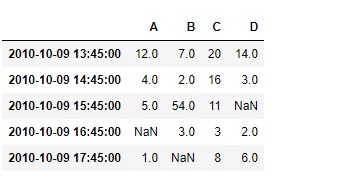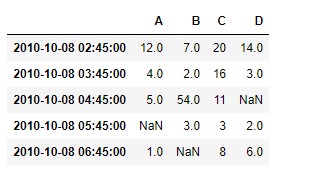Pandas DataFrame是带有标签轴(行和列)的二维大小可变的,可能是异构的表格数据结构。算术运算在行和列标签上对齐。可以将其视为Series对象的dict-like容器。这是 Pandas 的主要数据结构。
Pandas DataFrame.tshift()函数用于移动时间索引,如果在给定的数据帧中可用,则使用索引的频率。
用法: DataFrame.tshift(periods=1, freq=None, axis=0)
参数:
periods:移动的周期数,可以是正数或负数
freq:从tseries模块或时间规则中使用的增量(例如“ EOM”)
axis:对应于包含索引的轴
返回:移动:NDFrame
范例1:采用DataFrame.tshift()函数将给定数据帧的基于日期时间的索引偏移5小时。
# importing pandas as pd
import pandas as pd
# Creating the DataFrame
df = pd.DataFrame({'Weight':[45, 88, 56, 15, 71],
'Name':['Sam', 'Andrea', 'Alex', 'Robin', 'Kia'],
'Age':[14, 25, 55, 8, 21]})
# Create the index
index_ = pd.date_range('2010-10-09 08:45', periods = 5, freq ='H')
# Set the index
df.index = index_
# Print the DataFrame
print(df)输出:

现在我们将使用DataFrame.tshift()函数将给定数据帧的基于日期时间的索引偏移5小时。我们将“ 5H”作为频率值传递给该函数。
# Shift by 5 hours
result = df.tshift(freq = '5H')
# Print the result
print(result)输出:

正如我们在输出中看到的,DataFrame.tshift()函数已成功将给定数据帧的基于日期时间的索引移动了指定频率。
范例2:采用DataFrame.tshift()函数将给定数据帧的基于日期时间的索引偏移-30个周期。
# importing pandas as pd
import pandas as pd
# Creating the DataFrame
df = pd.DataFrame({'Weight':[45, 88, 56, 15, 71],
'Name':['Sam', 'Andrea', 'Alex', 'Robin', 'Kia'],
'Age':[14, 25, 55, 8, 21]})
# Create the index
index_ = pd.date_range('2010-10-09 08:45', periods = 5, freq ='H')
# Set the index
df.index = index_
# Print the DataFrame
print(df)输出:

现在我们将使用DataFrame.tshift()函数将给定数据帧的基于日期时间的索引偏移-30个周期。这会将过去30个周期的相同频率的索引移位。
# Shift by -30 periods
result = df.tshift(periods = -30)
# Print the result
print(result)输出:

正如我们在输出中看到的,DataFrame.tshift()函数已成功将给定数据帧的基于日期时间的索引移位了指定时间段。
相关用法
- Python pandas.map()用法及代码示例
- Python Pandas Series.str.len()用法及代码示例
- Python Pandas.factorize()用法及代码示例
- Python Pandas TimedeltaIndex.name用法及代码示例
- Python Pandas dataframe.ne()用法及代码示例
- Python Pandas Series.between()用法及代码示例
- Python Pandas DataFrame.where()用法及代码示例
- Python Pandas Series.add()用法及代码示例
- Python Pandas.pivot_table()用法及代码示例
- Python Pandas Series.mod()用法及代码示例
- Python Pandas Dataframe.at[ ]用法及代码示例
- Python Pandas Dataframe.iat[ ]用法及代码示例
- Python Pandas.pivot()用法及代码示例
- Python Pandas dataframe.mul()用法及代码示例
- Python Pandas.melt()用法及代码示例
注:本文由纯净天空筛选整理自Shubham__Ranjan大神的英文原创作品 Python | Pandas DataFrame.tshift。非经特殊声明,原始代码版权归原作者所有,本译文未经允许或授权,请勿转载或复制。
